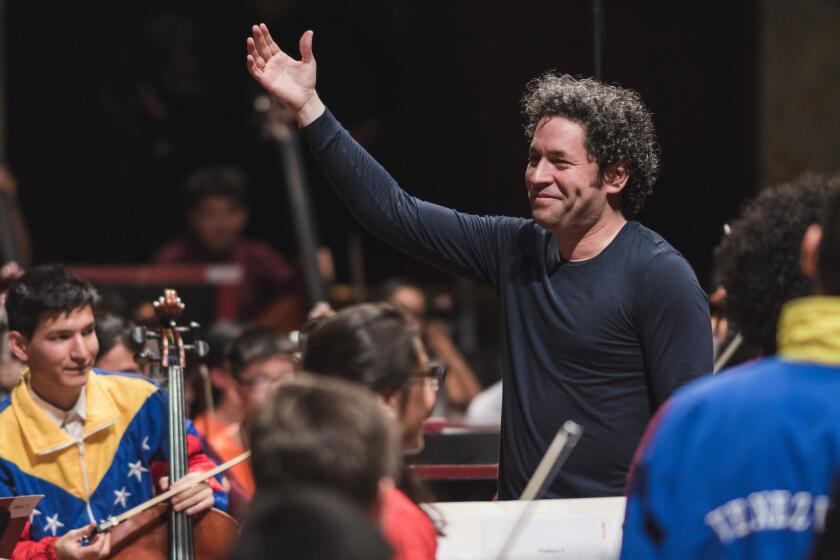Auto-Biography : Museums: Facility will celebrate the history of the car in Southern California. Officials hope it will also help rejuvenate Miracle Mile.
- Share via
Whether one loves or hates automobiles, the history of Los Angeles and the rest of Southern California is inextricably linked to our wheels.
*
Automobiles have defined where and how Angelenos have lived, said Catherine Krell, deputy director of the Los Angeles County Natural History Museum. Suburbs and billboards were created because of autos. The world’s first drive-through grocery store and drive-in church originated in Southern California.
So why not celebrate our passion for pistons?
That’s the idea behind the Petersen Automotive Museum, which will soon open in the former Orbach’s building at Wilshire Boulevard and Fairfax Avenue. Natural History Museum officials are overseeing construction of the museum.
Officials said this week that plans are on track to meet the projected June 10 opening date, despite the Jan. 17 quake that prompted additional work to fortify the building against future quakes.
One aim is to turn a deteriorating building that had been vacant for three years into a jewel that will help rejuvenate the Miracle Mile area of Wilshire Boulevard, officials said. The museum is expected to draw 2 million visitors in its first year, many of them from operators of two sightseeing tours that will add the Petersen to their rounds.
“We are very supportive of the museum,” said Renee Weitzer, a planning deputy for Los Angeles Councilman John Ferraro, who represents the area. “It will be a great impact on a building that has been an eyesore and had a problem with vagrants. It will help revitalize the Miracle Mile.”
With more than 13 million automobiles on the streets of Greater Los Angeles, the museum is a natural for the area, said Matthew Roth, a staff member at the Natural History Museum who will be lead curator at the Petersen.
“Los Angeles is the capital of car consumption,” Roth said.
The Petersen Automotive Museum will provide a cultural and educational spin through automotive history with detailed displays of about 200 authentic cars, as well as motorcycles, photographs, billboards and dioramas.
About 10 museums in the nation are devoted to the automobile, including three in California. They are in Sylmar, San Diego and Danville. But Krell said the Petersen, in a four-story, 300,000-square-foot building, will be the largest in the country and will have the most comprehensive exhibits.
*
“There’s nothing like us. We’re part of the Natural History Museum, which means it’s big and serious. No museum deals with the impact of the auto as fully and as comprehensively as we will.”
The museum is expected to cost about $50 million, Krell said. It is named after Robert Petersen, the founder and chairman of Petersen Publishing Co., who donated $15 million toward its establishment. His company publishes 30 magazines, including Motor Trend and Hot Rod. The history museum also obtained $20 million in bond money from Los Angeles County. Money was also given by benefactors and by corporations such as Arco.
The focus of the museum will be education, Krell said, with information in English, Spanish, German and Japanese. Each of the first three floors will trace the history of the auto, and conference rooms will be located on the fourth floor.
The first floor, dubbed “Streetscape,” begins a journey through the 1900s. There is a scene of a Breer Blacksmith Shop with a 1901 steam car, complete with cobwebs and reconstructed tools. There is a diorama of a 1911 American Underslung stuck in the mud in Las Tunas Canyon with a chauffeur and stranded motorists. Further along is a Laurel and Hardy scene depicting a crushed Model-T sitting between two trolley cars in Los Angeles.
Other exhibits include representations of Los Angeles’ first L-shaped mini-mall and one of the first California Highway Patrol motorcycle officers perched behind a billboard in the 1930s.
The second floor will include five rotating galleries with themes such as French luxury cars of the 1930s; Hollywood and the automobile; early motorcycles, and past and present automotive technology. The third floor will provide more views of Southern California car culture, with three art galleries of photography, toys and memorabilia. The museum began collecting automobiles in the 1930s as anthropological artifacts.
Natural History Museum officials decided to build a world-class automotive museum as a way to showcase its inventory of automobile memorabilia, which has been warehoused because of a lack of display space, Krell said.
More to Read
The biggest entertainment stories
Get our big stories about Hollywood, film, television, music, arts, culture and more right in your inbox as soon as they publish.
You may occasionally receive promotional content from the Los Angeles Times.










